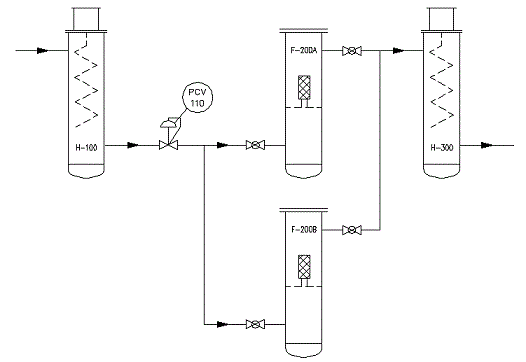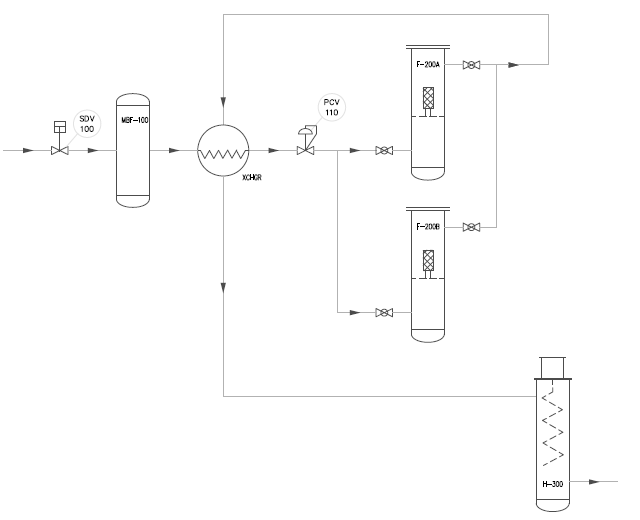Overview – Gas Turbine
Fuel Gas Conditioning System for treatment of turbine or combustion turbine fuel gas are also known as Fuel Gas Skid, Fuel Gas System and Fuel Gas Filtration and Heating. The treatment of fuel gas is crucial to the performance and longevity of gas turbine. In certain cases, gas turbine fuel gas treatment is required to meet the fuel requirement and warranty of the gas turbine.
A well design fuel treatment system for combustion turbine should remove the offending contamination and provide the necessary superheating of the fuel gas. Contamination in fuel can be categorized into gas, solids, liquid form. A few common contaminations that are removed by fuel treatment for gas turbines may include
| Contamination | Example | Effect |
| Solid | Rust, Mill Scale, Sand | Erosion and deposit in the hot section |
| Liquid | Water, Condensed gas, Heavy Hydrocarbon, Lube Oil from upstream reciprocating compressor. | Hot Spot in combustor. Missed Emission Deposit on injector. |
| Gas | Siloxane, Hydrogen Sulfide | Deposit and corrosion of hot section |
A basic fuel gas conditioning system will remove solid and liquid contamination utilizing ultra efficient coalescing filter element. After solid and liquid removal, the gas is superheated utilizing electric heater or other means of heating. Following is a typical block diagram of a basic fuel gas conditioning system.

Untreated fuel gas enters pre-heater H-100. This heater may be required to prevent the formation of hydrate due to pressure and temperature drop across pressure regulator PCV-110. The formation of hydrate depends on the presence of free water, gas composition and amount of pressure drop across PCV-110. When required, H-110 will raise the temperature of the gas above its hydrate formation temperature as the gas is regulated through PCV-110.
Pressure regulator PCV-110 is employed to regulate the pressure of the gas when the supply pressure exceeds the requirement of the gas turbine fuel system.
Once the gas is at the correct pressure, it goes though one of the two high efficiency filter coalescer F-200A/B. These are 2 x 100% rated filter coalescer that would enable the changing of the filter without disrupting the fuel supply to the gas turbine.
A high efficiency coalescing element with an 99.99% efficiency of 0.3 micron may be required whenever there are reciprocating compressor located upstream of the gas supply chain . We have seen many instance where the lube oil from these compressor making it way to the fuel system of gas turbine and causing problem. Thus, it is imperative that the fuel gas conditioning system is design with them in mind.
At this point the gas is saturated since all free liquid have been removed by the filter coalescer (worst case scenario). By providing the necessary differential temperature rise across super heater H-300, we are assured that the gas has met the minimum superheat requirement of the gas turbine specification.
Capabilities
Super heater H-300 is employed to provide the required superheating.
Fuel Gas Super heater H-300 is also known as Fuel Gas Dew Point Heater
Our approach is to provide all the super heating across this heater. For instance, if the gas turbine required 50 degrees superheat, the heater will be sized to provide 50 degrees temperature rise across it. We also recommend EML Manufacturing electric heaters due to their instant on capability, no emission, and reliability compared other types heating method.
Advantage
EML Manufacturing has extensive knowledge and experience in the design of fuel gas conditioning system for major gas turbine manufacturers.
In certain application it may be desirable to heat up the fuel gas to a higher temperature to enhance the efficiency of the gas turbine. This is also known as Fuel Gas Performance Heating or Fuel Gas Performance Heater. Typically these are shell and tube exchangers that utilized the waste heat from the gas turbine to heat the fuel gas. We offer complete fuel gas performance heating skid for major gas turbines.
Occasionally the fuel gas supply pressure is lower than the required fuel gas pressure at the gas turbine. In this instance a fuel gas compressor is required to boost the fuel gas pressure to the required.
There are many choices of gas compressor. However an oil free centrifugal compressor offers an advantage in fuel gas application. The advantage of an oil free compressor is that the fuel gas will not be contaminated with lube oil. All lubricated compressor will have lube oil carry over unless there are specially filtered to remove 100% of the lube oil carry over. Lube oil carry over even at ppm level will eventually accumulate low point of the downstream piping, equipment and manifold of the gas turbine. Eventually the oil will enter the combustion chamber and cause costly damage.
EML Manufacturing offers a line of oil free compressor with a staring flow rate of 4 MMSCFD.
Fuel Gas Performance Heating
It may be desirable to increase the efficiency of a combine cycle power plant utilizing gas turbine. One method is to utilize the waste heat of the gas turbine to heat up the inlet fuel gas. This results in increase thermal efficiency. EML Manufacturing can offer stand alone fuel gas performance heater or package on as a turnkey unit.

Overview – Internal Combustion
Fuel gas conditioning skid for Internal Combustion Engines is designed to treat fuel gas for use in gas/piston engines for driving electric generator or reciprocating compressors.
In some instances, the fuel gas source is too rich and would require the heavier hydrocarbon to be removed before the engine can consume the gas. Some manufacturer may specify the Methane number or the Lower Heating Value of the fuel gas. Currently the few technologies available to accomplish this are
– JT Valve (Joule Thomson Valve) – This system as shown in Fig 2 below utilized the cooling effect from the pressure reduction valve in conjunction with the lower pressure to condense the heavy hydrocarbon from the gas stream. The higher the pressure let down the more effective is this system. A heat exchanger is utilized to recover energy in the system.
– Membrane System. A membrane system utilized the different diffusion rate of the gases through the membrane media to separate the heavy hydrocarbon from the gas stream. In most cases the membrane system requires pressure drop across the membrane to function. In addition, the rejected rich gas could be 40 to 60% of the supply. Thus, this system is not suitable for end of the line application where there is no place to dispose of the rich gas stream.
– Refrigeration Chiller System. A refrigeration chiller system is utilized to chill the gas below the dew point of the heavy hydrocarbon. The liquid hydrocarbon is then separated from the gas stream utilizing high efficiency filter coalescer.
– A combination of technology above may be utilized to treat the fuel gas. For example, a refrigeration unit may be used in conjunction with a JT valve.

Instrument Gas Dryer & Hydrogen Sulfide (H2S) Scrubber
It is common to use natural gas a pneumatic source for instruments. This will be similar to instrument air. As in instrument air, the gas needs to be condition to make it suitable as instrument gas. As part of the instrument gas conditioning, water is removed from the gas to provide a low dew point. In other words, the gas is dehydrated. The removal of moisture is essential to provide long life and trouble free operation of instrument.
We design and manufacture both heated and heatless regenerative instrument gas dryer. These units are designed to remove moisture from the instrument gas.
In some application, the gas may contain Hydrogen Sulfide, H2S. In large quantity H2S is toxic and in smaller quantity it may be corrosive. It will also cause sulfide stress cracking in metallic parts. Therefore, it may be desirable to scrub the H2S from the gas stream.
We offer H2S absorber beds that are design to remove H2S from the natural gas stream
Vapor Recovery Units
EML Manufacturing can design Vapor Recovery Unit to capture hydrocarbon emission from storage tank or equipment. The captured hydrocarbon vapors can be treated for various uses. If the BTU content it too low it may be send to the flare or mixed with rich fuel gas for combustion. Depending on the composition of the vapor, it can be treated for use in burners, boilers, flare or even micro turbines.
We also consult with customers that have issues with their fuel system. Feel free to contact us with your fuel gas issues.
